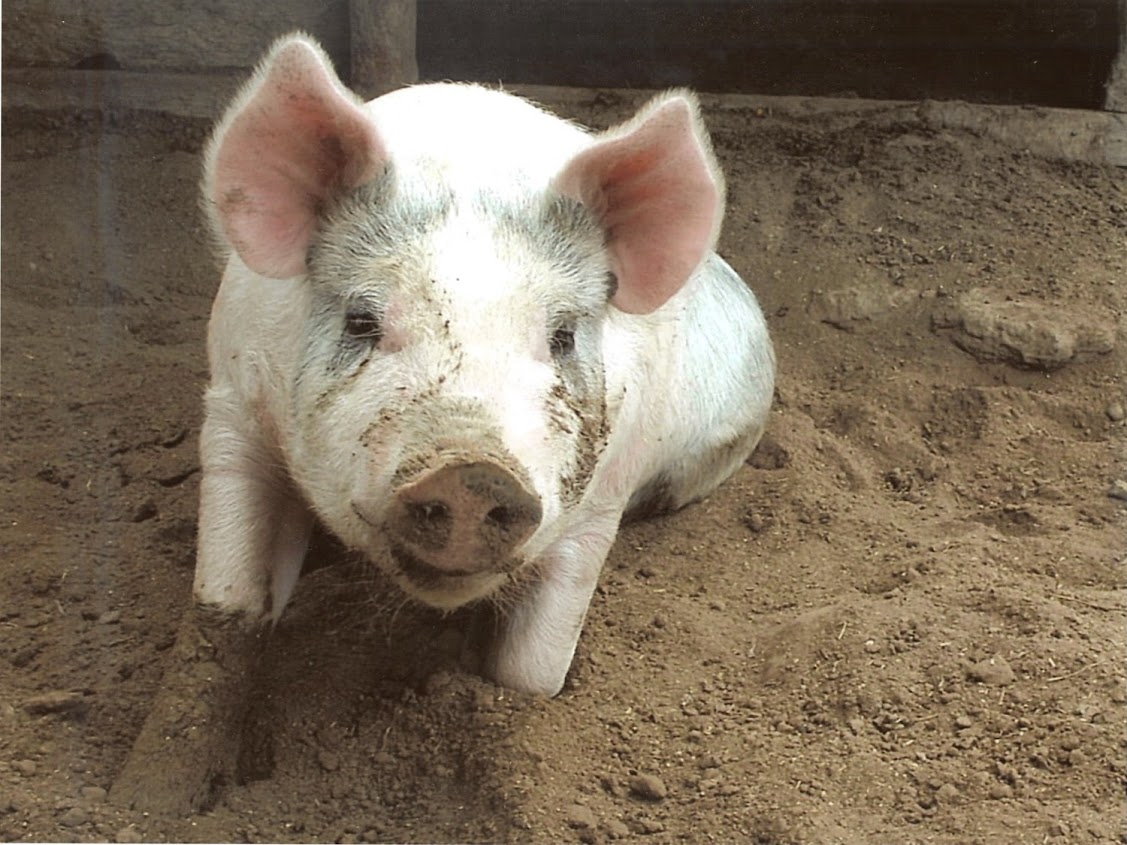Maintaining Pig Temperatures in the Summer and Winter Seasons

Introduction
Utah often faces extreme temperatures in the summer and winter seasons. Due to the adverse weather, it can be difficult to raise pigs. The following fact sheet discusses ways to help pigs adjust to hot and cold temperatures with facilities and management techniques.
The Importance of Temperature Control
Because pigs lack sweat glands and a substantial fur hide, summer and winter temperature extremes can affect pigs more than other livestock species (Hines, 2018). When any animal feels uncomfortable, whether too hot or too cold, the risk for sickness, disease, or even death increases. While the major concern is always pig health and welfare, there is also a large economic downfall when pigs are subject to temperature extremes. Lower rate of gains, reduced pregnancy rates, delayed time to estrus, reduced feed efficiency, increased sickness, and death can all have a huge impact on a producer’s bottom line and can result from poor temperature control (Washington State University [WSU] Extension, 2022; Hines, 2018).
Avoiding the Heat
During the summer, most areas in Utah will experience temperatures over 100 °F, but due to the arid climate, humidity levels stay low. However, once temperatures exceed 80 °F, pigs over 100 pounds can transition quickly into life threatening levels of heat stress (Figure 1).
Below are some ways to mitigate heat stress during the summer months.
- Increase Water Consumption: Offer pigs twice as much water than usually offered, and offer it more frequently. Use automatic waterers wherever possible to ensure continuous cold water availability (Hines, 2018). Ensure pipes or hoses delivering water to pigs are insulated, buried in the soil, or out of direct sunlight exposure, as pigs will not drink hot water (WSU Extension, 2022).
- Use Evaporative Cooling: Utilizing misters or sprinklers can help pigs cool off by misting or dripping water on their skin, thus increasing heat loss from their bodies. Mud holes can also help alleviate heat stress, but they can become unsanitary very quickly (WSU Extension, 2022).
- Handle Pigs During Cooler Weather: Early morning and late at night can be the best time to handle pigs. Handling pigs during the hottest times of the day can lead to heat stress problems quickly (Hines, 2018).
- Monitor Pigs’ Behavior: During the heat of the summer, monitoring pig feed intake, water consumption, activity level (cooler parts of the day), and general behavior can identify pigs struggling with heat stress or sickness (WSU Extension, 2022).
- Maintain Facility Cooling and Ventilation: Check facility ventilation frequently through the summer. Ensure that air inlets are open, and fans are operational, pushing air out of the building. If raising pigs outdoors, provide shade with fans and use a mister system during the hottest part of the day (Hines, 2018; WSU Extension, 2022). Air flow and ventilation can be a key component in protecting pigs from suffering from heat stress.

Avoiding the Cold
Often, much attention is focused on avoiding heat with pigs due to the lack of sweat glands. However, it is equally important that pigs have facilities that can help them get out of the cold and stay warm. While cold stress is not seen in pigs until it reaches extreme levels, there are still some underlying symptoms that can be hard on pigs as well as the operation’s bottom line.
When pigs get cold, much of their energy and resources are used to produce adequate heat and maintain body condition. Because of this, when pigs become cold, they may need up to three times the amount of feed to gain or maintain weight (Hines, 2019). This could put many pig operations out of business very quickly. To help avoid these issues and keep pigs out of the cold, here are some ways to mitigate cold stress during the winter months.

- Maintain Water Consumption: Although water is stressed during the summer months, do not forget its importance in the winter. With colder temperatures in the winter, water can often freeze. It is essential that cool, fresh water is always available for pigs. For this reason, we suggest automatic waterers in a temperature-controlled building when raising pigs.
- Maintain thermoneutral zones: Pigs’ thermoneutral zones vary by age. Younger pigs need higher temperatures, while older pigs’ thermoneutral zones fall to lower temperatures (Fabian & Hines, 2019). By managing your operation so that pigs at different ages are matched according to their thermoneutral zones, the operation’s efficiency will increase, and pigs will be much happier (Hines, 2019). Find a table with thermoneutral zones by a pig’s age in Cold Temperature Management for Pigs at https://extension.psu.edu/cold-temperature-management-for-pigs (Hines, 2019).
- Provide Winter Housing: As pigs lack a thick coat of hair, housing is needed in the winter months to ensure these animals receive proper care. There are many housing options available for pigs, and the following Penn State Extension website effectively lists and describes different winter housing types: https://extension.psu.edu/winter-housing-for-pigs-welfare.
- Maintain Housing Ventilation: Many operators may be tempted to decrease ventilation so that they can conserve the heat their pigs are giving off. However, when ventilation is shut off, it also allows harmful pig by-products to build up causing more problems for the future (Fabian & Hines, 2019). It may cost more money to warm the building while ventilation is running, but in the end, it will avoid any serious disasters from sickness or disease.
- Offer Bedding: Bedding can be a great addition in keeping pigs warm in the winter months. When choosing bedding try to find materials that are dry and insulate well. Straw, sawdust (wood by-products), and sand have all been used for bedding among livestock species. When adding bedding, remember to remove and add bedding accordingly. As bedding gets wet or soiled, it loses its insulative value, making it useless. Hence, changing bedding is an essential step in maintaining pig temperatures. Once bedding is put into pens, encourage pigs to defecate in a small limited area, avoiding bedding areas. Doing this helps reduce the number of times that bedding needs to be removed and added during the winter season. In temperature-controlled housing, bedding may be used but is not necessary.
Conclusion
Many factors go into a successful pig operation. In Utah, it is important to mitigate extreme temperatures to provide a comfortable environment. Pigs given recommended housing, bedding, and temperature levels will exhibit less stress and gain or maintain weight levels. All of these efforts add up to healthier pigs for a more successful operation overall.
Sources
- Fabian, E. E. & Hines, E. (2019). Winter housing for swine welfare [Article]. Penn State Extension. https://extension.psu.edu/winter-housing-for-pigs-welfare#:~:text=Cold%20and%20warm%20housing%20both,to%20maintain%20good%20air%20quality
- Hines, E. (2018). Keeping pigs cool in the summer heat [Fact sheet]. Penn State Extension. https://extension.psu.edu/keeping-pigs-cool-in-the-summer-heat#:~:text=Provide%20plenty%20of%20water%3A%20Offer,to%20let%20pigs%20get%20wet
- Hines, E. (2019). Cold temperature management for pigs [Article]. Penn State Extension. https://extension.psu.edu/cold-temperature-management-for-pigs
- Washington State University (WSU) Extension. (2022). Summer management of growing finishing swine – including show pigs [Fact sheet]. College of Agriculture, Human, and Natural Resource Sciences, Washington State University. https://extension.wsu.edu/animalag/content/summer-management-of-growing-finishing-pigs-including-show-pigs/
- Xin, H. & Harmon, J. (1998). Heat stress indices for livestock. Livestock Industry Facilities & Environment: Iowa State University. https://dr.lib.iastate.edu/server/api/core/bitstreams/0664c6e0-4d01-4278-966f-27e35a342a31/content
Published March 2023
Utah State University Extension
Peer-reviewed fact sheet
Authors
Jacob Hadfield, Jessie Hadfield, and Josh Dallin, Utah State University
Lorie Millward, Thanksgiving Point Institute

